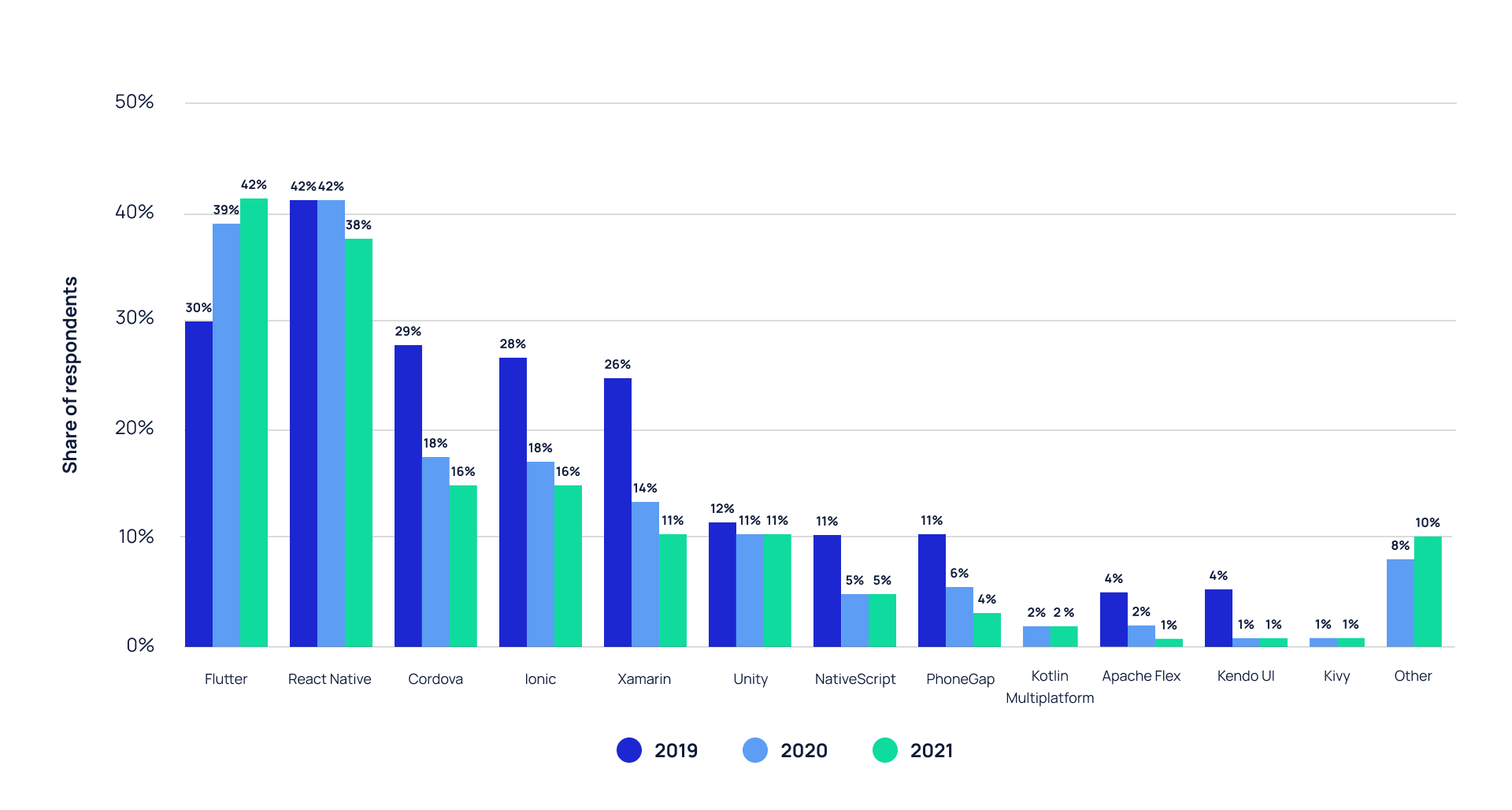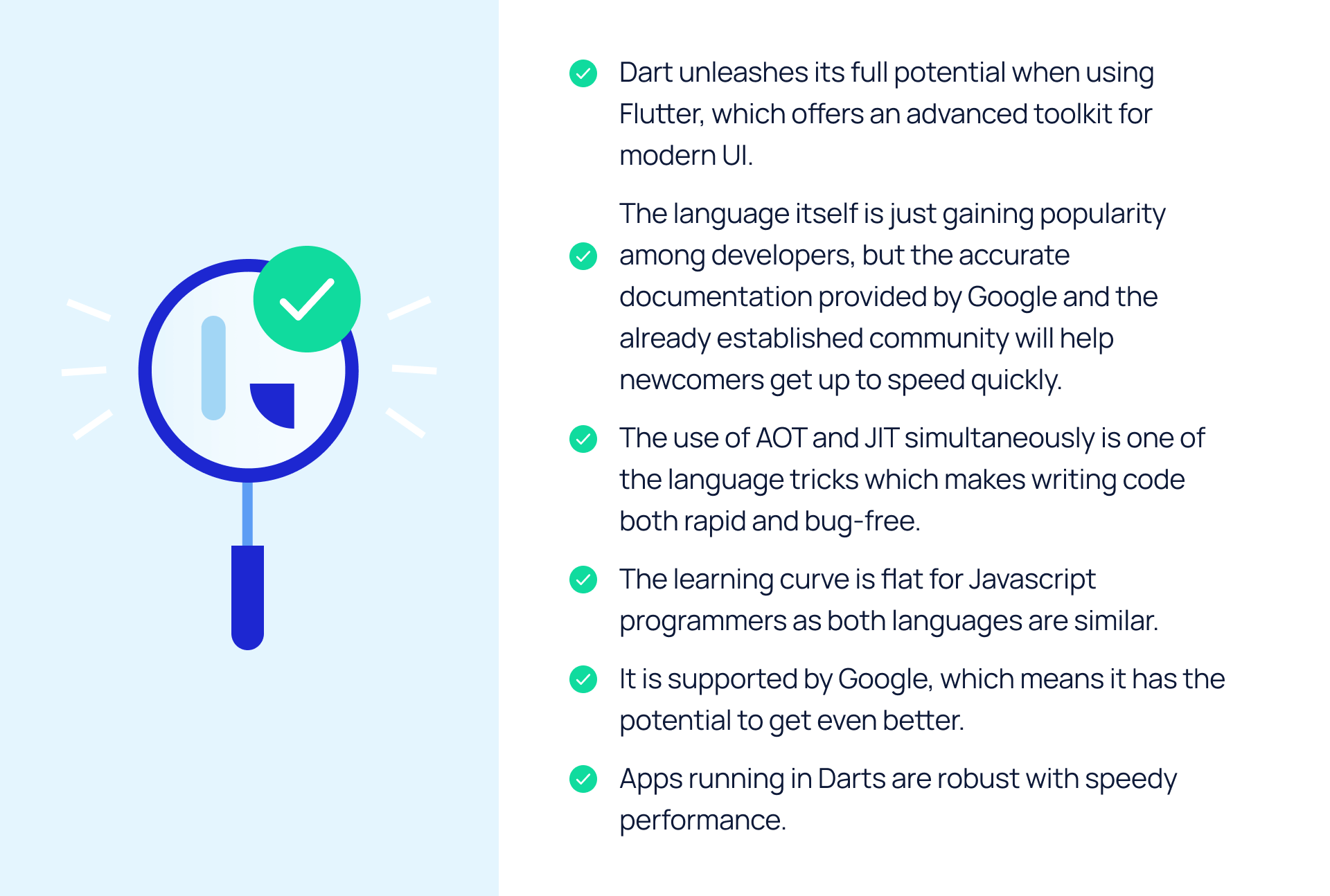How Dart can assist in integrating your web and mobile apps

What is the potential of Dart programming language for developing cross-platform applications? Dart as the backbone of Flutter — an open-source UI framework.
Every business will have to face the challenge of choosing a technical stack once it reaches the stage where it is aiming to effectively and economically expand its presence on the internet.
In addition, tech-savvy users crave your product's usability and accessibility from anywhere in the world. As a result, web and mobile integration is no longer just a possibility but rather a necessity for companies to stay on top of user expectations.
Where is the foundation? The language aspect is of particular importance, which determines the further development and scalability of the product. Well, should I opt for JavaScript, Kotlin, Python, or PHP? Of course, the choice depends on your business goals and what solution you want to provide. But today, I propose to take a look at one of the programming language options — Dart.
What is its feature set, and could it be the choice for deploying cross-platform solutions in one fell swoop?

Dart from the inside
Launched by Google, Dart is considered a multi-platform productivity-optimized language targeted for developing mobile, desktop, and web applications.
The Dart language supports both Ahead of time and Just in time compilations. The JIT compilation is performed during the coding, while AOT is used when the app is ready for launch. As a result, Dart allows lightning-fast development, speedy product execution, and roll-out using these two modes. In addition, developers have greater control over the system and are able to troubleshoot coding errors during the workflow.

Frameworks in Dart for robust app delivery
AngularDart
AngularDart, built using Dart, is an advanced framework for robust web development, which evolved out of the original Angular project. Although the architectural foundations remained the same, there were some notable improvements.
Despite the ample support and many extensive libraries, AngularJs does not fully meet the needs of many developers. As a consequence, it gives way to AngularDart, which intends to close the technical flaws present in AngularJS. AngularDart provides the advantages of a better thought out Dart than JavaScript while maintaining Angular's flexibility and power.
Although initially used only for Google products development (Fiber, Google Play Console, or Google Ads, for example), the contemporary application is much more widespread, with projects like Wrike or Trustwave heavily relying on AngularDart [1].
Angular framework in Dart is used for quick web applications delivery with further scalable possibilities. The framework focuses on performance, efficiency, and stability, where Dart contributes with a well-designed type system and a better standard library. Moreover, Dart's similarity to JS makes it easy for developers to switch from one to the other.
Flutter
Given how it made Dart a more in-demand coding language, a lot of credit should go to Flutter, an open-source and cross-platform UI framework released by Google in 2017.
Flutter is a Dart-based SDK with which you can use one code for developing an app both for iOS and Android and, since recently, desktops. Moreover, the same apps you create for mobile are easily deployable on the web in any browser.
Flutter provides a toolkit for creating native feeling apps with similar functionality and performance. Moreover, a wide set of pre-built widgets allows programmers to create customized user interfaces and high-performing solutions. Such a “merge” of Dart and Flutter makes app engineering lightning fast. For this very reason, in 2021, Flutter, together with Dart, was widely used by developers globally, proving its superiority [2].

Until around 2017, Dart was only used in Google projects. Google programmers took advantage of the Dart web capacity to deliver apps like, for example, Fuchsia. . The Assistant team also uses Dart in Smart Displays. But as Flutter has been gaining momentum since 2017, Dart is also being adopted outside of Google: Alibaba, JetBrains, Adobe. BMW and eBay also leverage Dart-based Flutter for the realization of their mobile projects.
Flutter, in conjunction with Dart, is quite a flexible tech stack as it allows programmers to deal with the code efficiently. Thanks to the features, such as hot reload, developers are able to see the code changes without restarting the application. This way, the pace of development is significantly increased as programmers can focus on creating instead of waiting for builds to complete.
This combo is a cost-saver since you don't need to hire several dev teams to provide solutions for each platform. Fortunately, today's flexibility in tech options allows you to focus on delivering a native interface suitable for both web and mobile.
I find this tech stack to be quite future-proof, allowing teams to deliver robust web, mobile and desktop solutions in a speedy manner using one codebase.
To summarize the Dart's features

Medicine is digitalizing. In order to provide a reliable service with a solid database, it is worth opting for flexible solutions that ensure the mobility of users who can use your application on any platform and from any device. Selecting a suitable technical kit allows fulfilling all these conditions in one fell swoop.
Using Dart as one of the components of this stack to integrate web and mobile might be the right choice. Of course, there are many more technical variations, which we will talk to you about in the following articles. In the meantime, get in touch with our medical-focused tech team to figure out the right decision for your business mobility.
References:
- https://www.wappalyzer.com/technologies/web-frameworks/angulardart
- https://www.statista.com/statistics/869224/worldwide-software-developer-working-hours/
- https://dart.dev/overview
- https://dart.dev/resources/videos
- https://hackernoon.com/why-flutter-uses-dart-dd635a054ebf
- https://medium.com/hackernoon/10-good-reasons-why-you-should-learn-dart-4b257708a332
- https://www.quora.com/Why-would-I-use-AngularDart-instead-of-Angular
- https://angulardart.xyz/guide/architecture
 Medical Content Creation
Medical Content Creation
 Digital Product Development
Digital Product Development
 Growth Marketing
Growth Marketing
